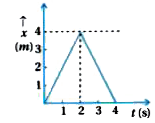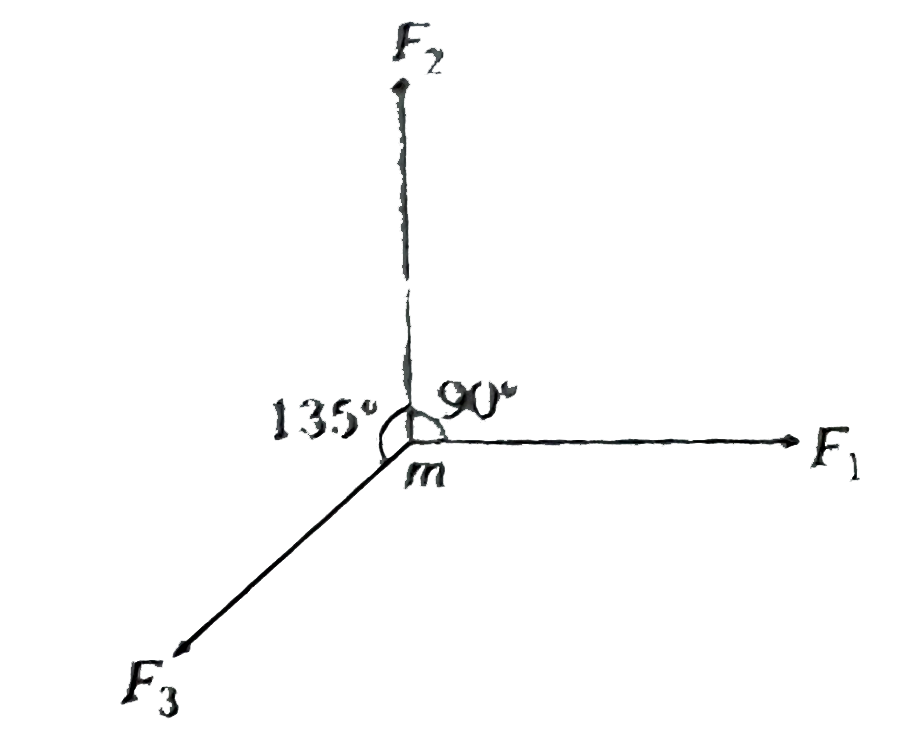There are three forces F1F2 and F3 acting on a body, all acting on a point P on the body. The body is found to move with uniform speed.
(a) Show that the forces are coplanar.
(b) Show that the torque acting on the body about any point due to these three forces is zero.Solution in Gujrati
As shown in figure three forces F1F2F3 act at point P on body

( a) Figure shows that forces are in same plane that is forces are coplaner body moves with constant uniform speed (velocity )
f=ma
−m(c)
F1+F2+F3=0
(b ) Calculating torque of these forces about point P .As forces passes through P torque about point P is zero .
Topper's Solved these Questions
- BOOK - KUMAR PRAKASHANCHAPTER - LAW OF MOTIONEXERCISE - SECTION -E(MULTIPLE CHOICE QUESTIONS) (MCQS)69videos
LAW OF MOTION
- BOOK - KUMAR PRAKASHANCHAPTER - LAW OF MOTIONEXERCISE - SECTION-F (QUESTIONS FROM MODULE)22videos
LAW OF MOTION
- BOOK - KUMAR PRAKASHANCHAPTER - LAW OF MOTIONEXERCISE - SECTION-C(OBJECTIVE QUESTIONS) (VSQS)55videos
LAW OF MOTION
- BOOK - KUMAR PRAKASHANCHAPTER - GRAVITATIONEXERCISE - QUESTIONS PAPER Section - D1videos
GRAVITATION
- BOOK - KUMAR PRAKASHANCHAPTER - MACHANICAL PROPERTIES OF SOLIDS EXERCISE - QUESTION PAPER11videos
MACHANICAL PROPERTIES OF SOLIDS
Similar Questions
The position (x) → time (t) graph of one dimensional motion of a body of mass 0.4 kg. What is the magnitude of impulse of force
 02:20View Solution
02:20View SolutionA block rests on a rough inclined plane making an angle of 30° with the horizontal. The coefficient of static friction between the block and the plane is 0.8. If the frictional force on the block is 10 N, the mass of the block ((in kg) is .......... (Take g = 10 m/s2)
03:26View SolutionArea of F → t graph gives which physical quantity ?
02:16View SolutionA spaceship is stationed on Mars. How much energy must be expended on the spaceship to launch it out of the solar system ? Mass of the spaceship = 1000 kg, mass of the sun =2×1030kg, mass of mars =6.4×1023kg, radius of mars = 3395 km, radius of the orbit of mars =2.28×108km,G=6.67×10−11Nm2kg2
02:14View SolutionWhat is called brittle material ?
02:37View SolutionIf the resultant torque of all the forces acting on a body is zero about a point is it necessary that it will be zero about any other point?
03:26View SolutionThere are three forces F_(1), F_(2) and F_(3) acting on a body , all acting on a point P on the body The body is found to moves with unifrom speed (a) Show that the forces are coplaner. (b) Show that the torque acting on the body about any point due to these three forces is zero .
02:33View SolutionFig shows three forces F_(1), F_(2) and F_(3) acting on a rod pivoted at its end. Find the torque of each force about pivot.
02:31View SolutionThere are three forces F_(1) , F_(2) and F_(3) acting on a body , all acting on a point P on the body . The body is found to move with uniform speed. (a) Show that the forces are coplanar. (b) Show that the torque acting on the body about any point due to these three forces is zero.
View SolutionWhen a force F acs on a body of mass m the acceleration product in the body is a . If htree equal forces F1=F2=F3=F act on the same body as shown in figure the accleration produced is
 01:40View Solution
01:40View SolutionA body is acted upon by two forces of manitudes F1=√2NandF2=3N which are inclined at 45∘ to each other. There magnitude of resultant force acting on the body is
03:50View SolutionThree forces →F1=5ˆi+6ˆj+7ˆk,→F2=−3ˆi−2ˆj−2ˆkand→F3=−2ˆi−4ˆj−3ˆk act on a body. What is the direction of the resultant force acting on the body ?
03:15View SolutionA : For a body to be in rotational equilibrium the net torque acting on the body about any point is zero.
R : For net torque to be zero, net force should also be zero.03:49View SolutionWhen a force F acts on a body of mass m, the acceleration produced in the body is a. If three equal forces F_(1) = F_(2)=F_(3)=F act on the same body as shown in figure the acceleration produced is
02:38View SolutionIf the resultant torque of all the forces acting on a body is zero about a point is it necessary that it will be zero about any other point?
02:32View Solution

